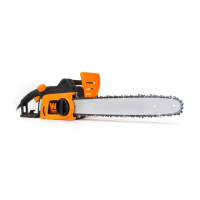16
Tree Limbing
Limb
Cut
Leave support limbs to keep work off the ground.
LIMBING A TREE
Limbing is removing the branches from a fallen tree.
When limbing leave larger lower limbs to support the log
off the ground. Remove the small limbs in one cut (Fig.
17). Branches under tension should be cut from the bot-
tom up to avoid binding the chain saw.
SAWING TECHNIQUES
Saw off the lower branches on the tree first. By doing so,
it is easier for the cut branches to fall to the ground.
At the end of the cut, the weight of the saw suddenly in-
creases for the user since it is no longer being supported
by a branch. There is a risk of losing control of the saw, so
make sure to stay alert during the entire sawing operation.
OPERATION
OPERATION
Only pull the saw out of a cut while the saw is running. By doing so, you prevent the chain from jamming in the
wood.
Do not saw with the tip of the guide bar. Do not saw into the branch formations (where the tree branches outwards).
This will impede the tree’s ability to heal.
For sawing off smaller branches, place the stop face of the saw on the branch. This prevents unwanted movements
of the saw at the beginning of the cut. While applying light pressure, guide the saw through the branch from top to
bottom.
For sawing off larger branches, first make a relief cut. Saw through 1/3 of the branch diameter from the bottom to
top using the top side of the guide bar. Then saw from top to bottom for the other 2/3 using the bottom side of the
guide bar. Saw off longer branches in sections in order to maintain control over the location of impact.
Fig. 17

